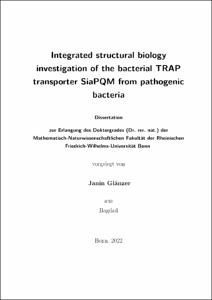Glänzer, Janin: Integrated structural biology investigation of the bacterial TRAP transporter SiaPQM from pathogenic bacteria. - Bonn, 2023. - Dissertation, Rheinische Friedrich-Wilhelms-Universität Bonn.
Online-Ausgabe in bonndoc: https://nbn-resolving.org/urn:nbn:de:hbz:5-72120
Online-Ausgabe in bonndoc: https://nbn-resolving.org/urn:nbn:de:hbz:5-72120
@phdthesis{handle:20.500.11811/11117,
urn: https://nbn-resolving.org/urn:nbn:de:hbz:5-72120,
author = {{Janin Glänzer}},
title = {Integrated structural biology investigation of the bacterial TRAP transporter SiaPQM from pathogenic bacteria},
school = {Rheinische Friedrich-Wilhelms-Universität Bonn},
year = 2023,
month = oct,
note = {Sialic acid is utilized by human pathogens like Vibrio cholerae in various ways to colonize the host. Upon contamination it scavenges the sialic acid from mucus-rich parts of the body such as the gut and causes the disease Cholera - for many countries still a reality of everyday life. Sialic acid acts as a carbon source, cell surface decoration and even as factor enhancing the virulence of this bacteria.
Vibrio cholerae uses the Tripartite ATP-independent periplasmic (TRAP) transporter VcSiaPQM to catch the scarce substrate and to translocate it within the inside of the cell. Also, it is the sole sialic acid transporter in Vibrio cholerae and interestingly is absent in humans which further makes it an interesting drug target.
This thesis investigates the substrate binding protein VcSiaP in an integrated structural biology approach using x-ray crystallography, electron paramagnetic resonance and microbiological techniques. VcSiaP was found to be exclusively in open conformation in solution. The closing is triggered by the binding substrate and therefore VcSiaP can function like a switch. Further, the hypothesis that the three binding cleft amino acids R125, E184 and H207 form an ionic triade which is responsible for protein closure was falsified.
For the first time, the binding of an artificial peptide by VcSiaP in crystal structure was observed. Moreover, the binding of this artificial substrate hints towards the idea that closing occurs through bringing both protein lobes closer together.
Other possible short peptide binders were identified with a peptide scan. However, the attempts to determine the binding affinity failed. Further, EPR experiments were conducted to detect the interaction between the periplasmic domain VcSiaP and the transmembrane part VcSiaQM. This was also not possible.
In a combined action of peptide scan use, uptake assays and bacterial growth assays the attempt was made to find a possible scooping loop of VcSiaP which would lead to opening of the protein and to substrate release.
Overall, the presented work contributes to a deeper understanding of the transporter and develops first routes to possible peptide inhibition in future.},
url = {https://hdl.handle.net/20.500.11811/11117}
}
urn: https://nbn-resolving.org/urn:nbn:de:hbz:5-72120,
author = {{Janin Glänzer}},
title = {Integrated structural biology investigation of the bacterial TRAP transporter SiaPQM from pathogenic bacteria},
school = {Rheinische Friedrich-Wilhelms-Universität Bonn},
year = 2023,
month = oct,
note = {Sialic acid is utilized by human pathogens like Vibrio cholerae in various ways to colonize the host. Upon contamination it scavenges the sialic acid from mucus-rich parts of the body such as the gut and causes the disease Cholera - for many countries still a reality of everyday life. Sialic acid acts as a carbon source, cell surface decoration and even as factor enhancing the virulence of this bacteria.
Vibrio cholerae uses the Tripartite ATP-independent periplasmic (TRAP) transporter VcSiaPQM to catch the scarce substrate and to translocate it within the inside of the cell. Also, it is the sole sialic acid transporter in Vibrio cholerae and interestingly is absent in humans which further makes it an interesting drug target.
This thesis investigates the substrate binding protein VcSiaP in an integrated structural biology approach using x-ray crystallography, electron paramagnetic resonance and microbiological techniques. VcSiaP was found to be exclusively in open conformation in solution. The closing is triggered by the binding substrate and therefore VcSiaP can function like a switch. Further, the hypothesis that the three binding cleft amino acids R125, E184 and H207 form an ionic triade which is responsible for protein closure was falsified.
For the first time, the binding of an artificial peptide by VcSiaP in crystal structure was observed. Moreover, the binding of this artificial substrate hints towards the idea that closing occurs through bringing both protein lobes closer together.
Other possible short peptide binders were identified with a peptide scan. However, the attempts to determine the binding affinity failed. Further, EPR experiments were conducted to detect the interaction between the periplasmic domain VcSiaP and the transmembrane part VcSiaQM. This was also not possible.
In a combined action of peptide scan use, uptake assays and bacterial growth assays the attempt was made to find a possible scooping loop of VcSiaP which would lead to opening of the protein and to substrate release.
Overall, the presented work contributes to a deeper understanding of the transporter and develops first routes to possible peptide inhibition in future.},
url = {https://hdl.handle.net/20.500.11811/11117}
}






